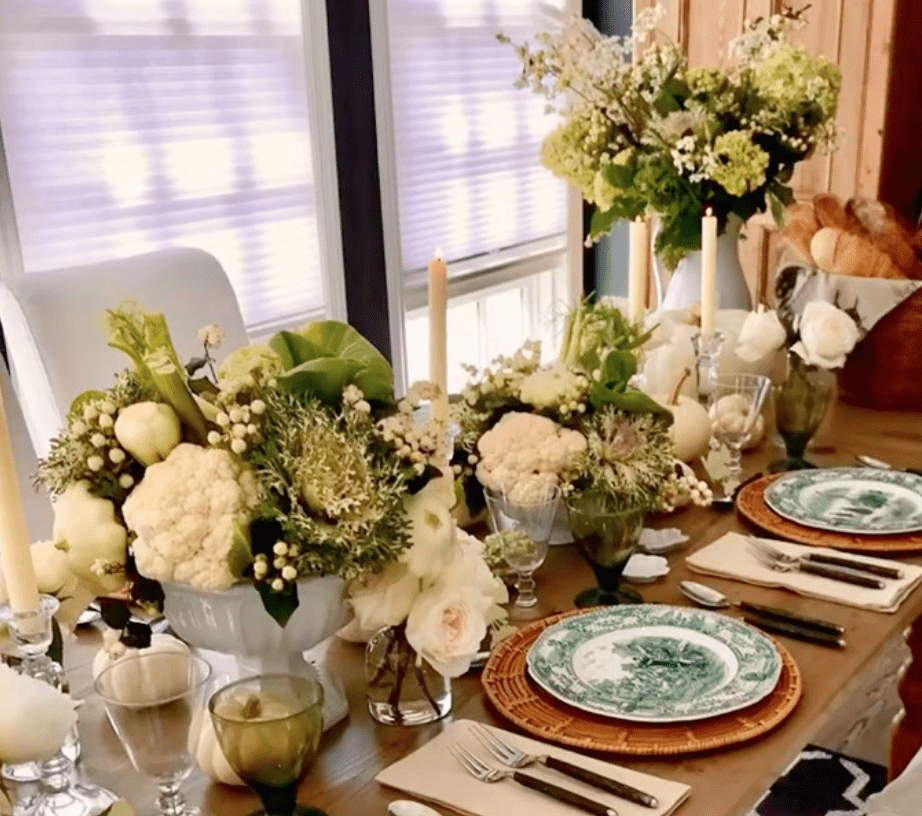Creative Ways to Use Fruits and Vegetables in Floral Designs
By Jill Brooke

Aren’t mixing fruits and vegetables into a table decor so enchanting? It feels earthy and special. Plus the textures of vegetables add so much to a design.
You may not know this but any time you create flower arrangements using vegetables and fruits, you are bringing a “Della Robbia” design into your world.
What is a Della Robbia floral design?
“Floral designs made mostly or entirely from fruits and vegetables are called Della Robbia designs, named after a family of Italian sculptors in the Italian Renaissance of the 15th and 16th centuries,” explains Texas master florist Beth O’Reilly. “This type of design not only has history, but it is also great for entertaining and quite a conversation piece.”
For holidays I often sprinkle vegetables on a base of moss to create that effect and add flowers too. In fact, it has become my design signature.

Former White House florist and author Laura Dowling lectures on how this decor style is not limited to indoor designs.
“The Della Robbia wreath is a timeless motif that is perfect for holiday decor outside,” she says. “I often use a mix of seasonal fruit and berries — and even more unusual things like potatoes and onions — to create my own interpretation of the style, which is so inspirational.”

Other world-renowned masters of this technique are over at the Bridgehampton Florist. Veteran florists Michael Grim and James Osborne routinely mix a variety of fruits and veggies into mantles as well as table decor. For those not wanting color, they use cauliflower so inventively mixed with cabbages. Everything they do makes you sigh in appreciation and marvel at their creativity.

So how can you create one of the towering floral designs?
“All you need is an assortment of your favorite fruits, veggies and blooms and a form to cover it with,” says O’Reilly. “In this instance, I used styrofoam and oasis foam.”
You can purchase the styro foams at any hobby store and reuse them for your culinary floral displays. The styro foam is actually made of 96% recycled plastic so you can feel good about reusing it. Most of it is actually made from recycled coat hangers! Wow.”
Wow indeed. So if you want to wow your family and friends, definitely consider adding fruits and vegetables.

5 Veggies Perfect for Table Decor
1) Broccoli
Great texture and when you put broccoli heads on a bed of moss you can put a flower on it or in between the florets for a dazzling effect

2) Pomegranate
Cut them in half and let the lush garnet seeds add sparkle. The glistening red color is great for fall and winter holiday parties. Or as the Bridgehampton Florist did above, just use them as decorative items.

3) Asparagus
Beth O’Reilly literally used this veggie inside a flower to add height to any display in a surprising but beautiful way. You can also put them in glasses along with carrots and a few greens and flowers bookending a larger floral arrangement. Here she also used radishes for great draping as well as Brussels sprouts, Kale, corn, Green Onions, Grapes and Apples. The flowers used were roses and carnations.
4) Artichokes
Put a stick in them and put them in between flowers for interesting texture. In fact, if you are doing a green-oriented themed arrangement, try adding unripe green bananas as well and then add some flowers.

5) Oranges, Apples, Lemons and Peaches
I often put a stick in an apple and insert it into a plant for a surprising pick-me-up treat. Apples work well because they are not as soft – ditto for lemons and oranges. Any of these fruits can be scattered around any floral display to pull the color of the roses, lilies or zinnias you may be using. However, apples will rot quickly when cut so use them whole – including crabapples. The Bridgehampton Florist also uses tiny tomatoes and eggplants for a nice effect.

Lemons and oranges can be cut and look pretty and last. You may also want to try tangerines since they are small and look fabulous scattered anywhere. Penny Karvounis made this dark wood table feel like a burst of spring using bright yellow forsythia along with lush Dutch tulips and friendly daffodils draped over the table. But what really made people smile was how this team used lemons and yellow tomatoes to accent the design. Little hints of lavender flowers and curling branches added the accessories needed for an overall wow effect.

My friend Carolyne Roehm loves using peaches as well as apples in her displays. The fuzziness of the fruit adds a lovely texture.
By the way, the term Della Robbia may be confusing. Luca Della Robbia was an innovative glazer in the 1440’s who developed a technique that produced molded pieces that could endure and be used outside. His vibrant polychrome glazes made the creations more durable. As Interiors Magazine editor Mitch Owens explains, many Della Robbia works have a harvest aspect, such as the Virgin and Child encircled by a frame modeled as a leafy garland studded with ripe pears and apples, succulent grapes and oranges. “It also has chestnuts erupting from their shells and more. It was a leitmotif of Luca Della Robbia’s work as well as of his nephew Andrea: fruit symbolizes fecundity, lushness, and nature at its most luxurious.”
The idea spread not only to plates and vases but to floral designs too.

So when you are creating your work, tell guests you are inspired by Della Robbia in bringing the harvest into designs and family gatherings. And most importantly, have fun. Bringing nature into your world always enhances the human experience.
